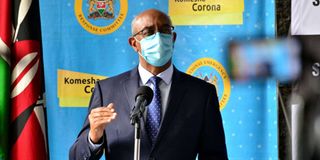Kenya's virus cases rise by 245 to reach 30,365, death toll now 482

Health Chief Administrative Secretary Rashid Aman briefs journalists at Afya House in Nairobi on August 14, 2020, on the Covid-19 pandemic in Kenya.
What you need to know:
- The Health ministry said eight more infected people had been reported dead in the last 24 hours while 504 more had recovered.
- Of those who died, five had underlying conditions, Chief Administrative Secretary Rashid Aman said in the daily briefing.
- CAS Aman said Nairobi and Mombasa had the highest attack rates, 406.8 and 184.1 per 100,000 people respectively, compared to the national average of 63.3.
- As of August 17, Nairobi had the highest number of cases - 17,889 - followed by Kiambu with 2,228, Mombasa with 2,224 and Kajiado with 1,627.
The number of coronavirus cases in Kenya increased by 245 Monday, with the Health ministry announcing the testing of 3,150 samples in the last 24 hours.
This raised the total number of confirmed Covid-19 cases to 30,365, including 482 deaths and 17,160 recoveries.
The ministry said eight more infected people had been reported dead in the last 24 hours while 504 more had recovered, 461 at home and 43 in hospitals.
Of those who died, five had underlying conditions, Chief Administrative Secretary Rashid Aman said in the daily briefing.
Dr Aman said 237 of the new patients were Kenyans and eight foreigners, while the youngest was a month old and the oldest 79. Males numbered 145 and females 100.

Community transmission
While reiterating the need for the public to exercise caution and observe all guidelines for slowing the spread of the virus, Dr Aman noted, "Over 29,000 cases in Kenya are communally spread, which is equivalent to 98 per cent of all cases."
The deadly virus was first confirmed in Wuhan, China, on December 31, 2019 and in Kenya on March 13.
Since then, all of the country's 47 counties have recorded patients while a total of 394,566 samples had been tested nationwide by August 17.
CAS Aman said Nairobi and Mombasa had the highest attack rates, 406.8 and 184.1 per 100,000 people respectively, compared to the national average of 63.3.
Nairobi accounted for 149 of the new patients, Kiambu 23, Kajiado 23, Mombasa 10, Garissa and Machakos nine each, Nyeri and Narok seven each, Busia four, Kilifi three, Laikipia, Murang'a and Kitui two each, and Kisumu, Uasin Gishu, Kwale and Tharaka-Nithi one each.
As of August 17, Nairobi had the highest number of cases - 17,889 - followed by Kiambu with 2,228, Mombasa with 2,224 and Kajiado with 1,627.
Elgeyo Marakwet and West Pokot counties were the least affected with six cases each.

Back to basics
The ministry focused on hand-washing in its reminder for the public to observe the very basic measures for containing the pandemic, which include wearing face masks and ensuring physical distancing.
Dr Aman gave instructions including using soap and water, a 0.05 per cent chlorine solution or approved disinfectant, and thorough scrubbing for at least 20 seconds.
He also noted the need for hand-washing equipment at places of worship, bus stops, markets, schools and other public places.
The CAS further asked health workers to stick to the World Health Organization's infection prevention and control (IPC) slogan, "My five moments for hand hygiene", which are "before touching a patient, before clean/aseptic procedures, after body fluid exposure or risk, after touching a patient and after touching patient surroundings."
In the case of water trucking, the ministry noted the need to check each one for residual chlorine, allow the water to settle before releasing it for use and ensuring tanks are cleaned regularly.





